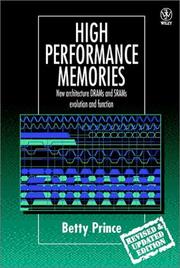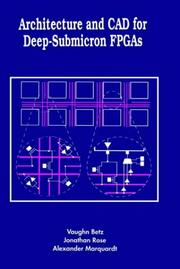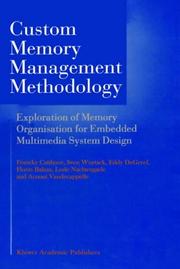| Listing 1 - 5 of 5 |
Sort by
|
Book
ISBN: 9780321700896 Year: 2012 Publisher: Pearson Education
Abstract | Keywords | Export | Availability | Bookmark
 Loading...
Loading...Choose an application
- Reference Manager
- EndNote
- RefWorks (Direct export to RefWorks)
Professional modeling is the foundation of every aspect of the 3D production pipeline and is essential to the success of any 3D computer graphics project. [digital] Modeling is unlike any other modeling book youve seenit gets to the core of what it takes to create efficient production-ready models and demystifies the process of producing realistic and jaw-dropping graphics. Taking a software-neutral approach, it teaches you the essential skills and concepts that you can apply to modeling in any industry 3D software, such as 3ds Max, LightWave 3D, Maya, Modo, Silo, XSI, ZBrush and other leading programs. Modelers, animators, texture artists, and technical directors can all benefit from the valuable information covered in this jam-packed guide containing years of industry knowledge. Simply put, if you work in 3D, you must have this book. In this inspiring and informative guide to modeling, industry veteran William Vaughan teaches you how to: Master modeling techniques to produce professional results in any 3D application Use the tools of a professional digital modeler Control your models polygon-count as well as polygon-flow Create both organic and hard surface models Understand a modelers role in a production environment Gain the knowledge to land a job in the industry as a digital modeler Model using specific tools such as LightWave and 3ds Max in over 6 hours of video training on the accompanying DVD
Computer. Automation --- CPU (central processing unit) --- 3D computertoepassingen --- visualisatie (informatica) --- grafische kaarten --- RAM (random access memory) --- ontwerpen --- visual programming --- Blender --- Blender (software)
Book
ISBN: 9780071701334 Year: 2010 Publisher: New York, N.Y. McGraw-Hill
Abstract | Keywords | Export | Availability | Bookmark
 Loading...
Loading...Choose an application
- Reference Manager
- EndNote
- RefWorks (Direct export to RefWorks)
Get complete coverage of the latest release of the CompTIA A+ exams inside this fully revised and updated resource. Written by the leading authority on CompTIA A+ certification and training, this expert guide covers CompTIA A+ exams 220-701 and 220-702. You'll find learning objectives at the beginning of each chapter, exam tips, practice exam questions, in-depth explanations, and more than 1,000 photographs and illustrations. Designed to help you pass the CompTIA A+ exams with ease, this definitive volume also serves as an essential on-the-job IT reference. Covers all exam objectives, including how to: Work with CPUs, RAM, motherboards, power supplies, and other PC components Install, partition, and format hard drives Install, upgrade, and troubleshoot WIndows 2000, Windows XP, and Windows Vista Troubleshoot PCs and implement security measures Install video and multimedia cards Work with portable PCs, PDAs, smartphones, and wireless technologies Manage printers and connect to networks and the Internet Understand safety and environmental issues Establish good communication skills and adhere to privacy policies The CD-ROM features: Practice exams for 701 & 702 600+ chapter review questions New video introduction to CompTIA A+ One-hour video training segment Mike's favorite PC tools and utilities Searchable e-book
Computer. Automation --- printers --- digitale fotografie --- RAM (random access memory) --- WLAN (wireless local area networks) --- smartphones --- motherboards --- multimedia --- MS Windows --- LAN (local area network) --- digitale video --- CMOS --- BIOS (basic input output system)

ISBN: 9780471986102 0471986100 Year: 1999 Publisher: Chichester Wiley
Abstract | Keywords | Export | Availability | Bookmark
 Loading...
Loading...Choose an application
- Reference Manager
- EndNote
- RefWorks (Direct export to RefWorks)
Semiconductor storage devices --- Very high speed integrated circuits --- 681.31 --- DIMM double-sided SIMM --- DRAM dynamic random access memory --- RAM random access memory --- SDRAM synchronous dynamic random access memory --- SIMM single-in-line memory model --- SRAM static random access memory --- cache geheugens --- geheugens --- hardware --- Computerarchitectuur. Informaticahardware. --- Semiconductor storage devices. --- Very high speed integrated circuits. --- VHSIC --- Integrated circuits --- Semiconductor memories --- Computer storage devices --- Semiconductors --- Computerarchitectuur. Informaticahardware --- Very large scale integration

ISBN: 0792384601 1461373425 1461551455 Year: 1999 Publisher: Boston Kluwer
Abstract | Keywords | Export | Availability | Bookmark
 Loading...
Loading...Choose an application
- Reference Manager
- EndNote
- RefWorks (Direct export to RefWorks)
Since their introduction in 1984, Field-Programmable Gate Arrays (FPGAs) have become one of the most popular implementation media for digital circuits and have grown into a $2 billion per year industry. As process geometries have shrunk into the deep-submicron region, the logic capacity of FPGAs has greatly increased, making FPGAs a viable implementation alternative for larger and larger designs. To make the best use of these new deep-submicron processes, one must re-design one's FPGAs and Computer- Aided Design (CAD) tools. Architecture and CAD for Deep-Submicron FPGAs addresses several key issues in the design of high-performance FPGA architectures and CAD tools, with particular emphasis on issues that are important for FPGAs implemented in deep-submicron processes. Three factors combine to determine the performance of an FPGA: the quality of the CAD tools used to map circuits into the FPGA, the quality of the FPGA architecture, and the electrical (i.e. transistor-level) design of the FPGA. Architecture and CAD for Deep-Submicron FPGAs examines all three of these issues in concert. In order to investigate the quality of different FPGA architectures, one needs CAD tools capable of automatically implementing circuits in each FPGA architecture of interest. Once a circuit has been implemented in an FPGA architecture, one next needs accurate area and delay models to evaluate the quality (speed achieved, area required) of the circuit implementation in the FPGA architecture under test. This book therefore has three major foci: the development of a high-quality and highly flexible CAD infrastructure, the creation of accurate area and delay models for FPGAs, and the study of several important FPGA architectural issues. Architecture and CAD for Deep-Submicron FPGAs is an essential reference for researchers, professionals and students interested in FPGAs.
-Programmable array logic --- CAD computer aided design --- FPGA field programmable gate arrays --- RAM random access memory --- SRAM static random access memory --- Field programmable gate arrays --- Programmable array logic --- 681.31 --- ontwerpen --- 681.3*B7 --- 681.3*B7 Integrated circuits (Hardware) --- Integrated circuits (Hardware) --- Array logic, Programmable --- Digital electronics --- Microprocessors --- Programmable logic devices --- Field programmable logic arrays --- FPGAs --- Gate array circuits --- Computer-aided design --- Computerarchitectuur. Informaticahardware --- Programmable array logic. --- Computer-aided design. --- Electronic circuits. --- Electrical engineering. --- Computer-aided engineering. --- Circuits and Systems. --- Electrical Engineering. --- Computer-Aided Engineering (CAD, CAE) and Design. --- CAE --- Engineering --- Electric engineering --- Electron-tube circuits --- Electric circuits --- Electron tubes --- Electronics --- Data processing

ISBN: 0792382889 1441950613 1475728492 Year: 1998 Publisher: Boston Kluwer
Abstract | Keywords | Export | Availability | Bookmark
 Loading...
Loading...Choose an application
- Reference Manager
- EndNote
- RefWorks (Direct export to RefWorks)
The main intention of this book is to give an impression of the state-of-the-art in system-level memory management (data transfer and storage) related issues for complex data-dominated real-time signal and data processing applications. The material is based on research at IMEC in this area in the period 1989- 1997. In order to deal with the stringent timing requirements and the data dominated characteristics of this domain, we have adopted a target architecture style and a systematic methodology to make the exploration and optimization of such systems feasible. Our approach is also very heavily application driven which is illustrated by several realistic demonstrators, partly used as red-thread examples in the book. Moreover, the book addresses only the steps above the traditional high-level synthesis (scheduling and allocation) or compilation (traditional or ILP oriented) tasks. The latter are mainly focussed on scalar or scalar stream operations and data where the internal structure of the complex data types is not exploited, in contrast to the approaches discussed here. The proposed methodologies are largely independent of the level of programmability in the data-path and controller so they are valuable for the realisation of both hardware and software systems. Our target domain consists of signal and data processing systems which deal with large amounts of data.
681.3*H51 --- Embedded computer systems --- Memory management (Computer science) --- 681.3*D34 --- #TELE:ACCA --- 004.451.43 --- CAD computer aided design --- RAM random access memory --- data transfer --- embedded systemen --- memory management --- multimedia --- Management of computer memory --- Computer storage devices --- Loop tiling (Computer science) --- Embedded systems (Computer systems) --- Computer systems --- Architecture Analysis and Design Language --- Multimedia information systems: audio input/output, video, hypertext navigation --- Processors: code generation; compilers; interpreters; optimization; parsing; preprocessors; run-time environments; translator writing systems and compilergenerators (Programming languages) --- Gelijktijdige on-line/directe werking van randapparatuur --- Embedded computer systems. --- Memory management (Computer science). --- 681.3*D34 Processors: code generation; compilers; interpreters; optimization; parsing; preprocessors; run-time environments; translator writing systems and compilergenerators (Programming languages) --- 681.3*H51 Multimedia information systems: audio input/output, video, hypertext navigation --- Computer-aided engineering. --- Special purpose computers. --- Electrical engineering. --- Multimedia information systems. --- Computer-Aided Engineering (CAD, CAE) and Design. --- Special Purpose and Application-Based Systems. --- Electrical Engineering. --- Multimedia Information Systems. --- Computer-based multimedia information systems --- Multimedia computing --- Multimedia information systems --- Multimedia knowledge systems --- Information storage and retrieval systems --- Electric engineering --- Engineering --- Special purpose computers --- Computers --- CAE --- Data processing
| Listing 1 - 5 of 5 |
Sort by
|

 Search
Search Feedback
Feedback About
About Help
Help News
News